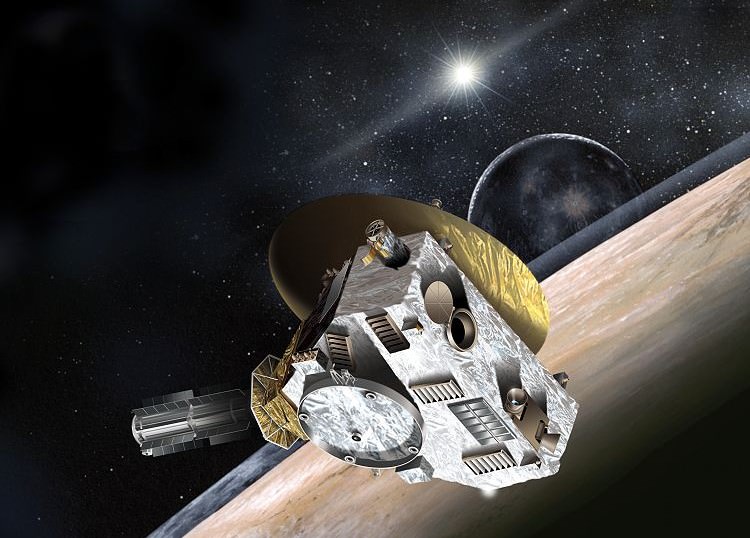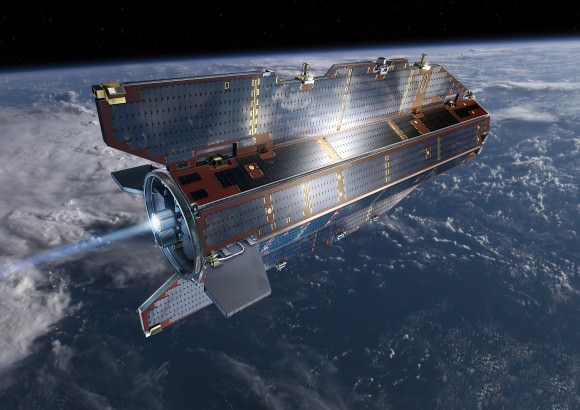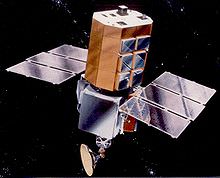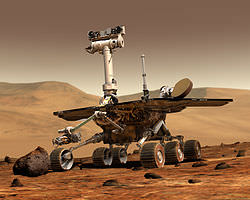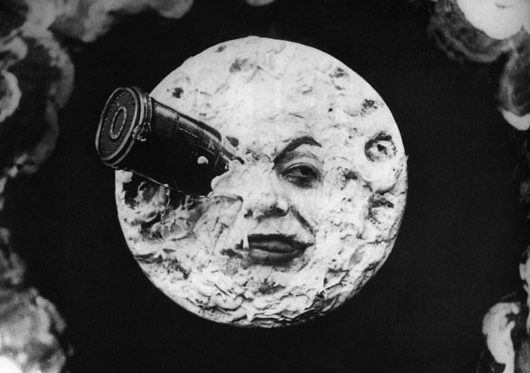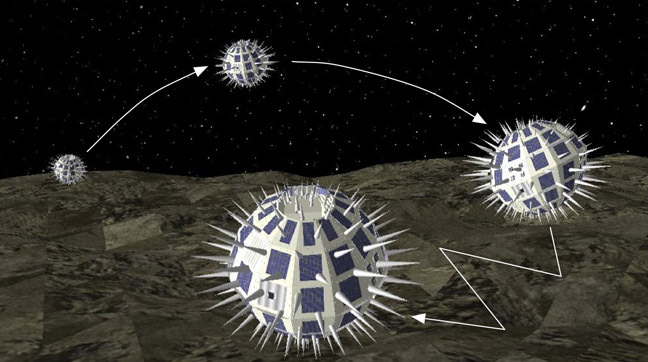SpaceShipOne is the spacecraft created by Scaled Composites to win the $10 million Ansari X-Prize in 2003. It was the first privately built spacecraft to reach 100 km in altitude, twice in two weeks, carrying the equivalent of 3 people. It’s the prototype of the upcoming SpaceShipTwo, created for Virgin Galactic to carry paying passengers into space.
Continue reading “Astronomy Cast 350: SpaceShipOne”
New Horizons Wakes Up for the Summer
While many kids in the U.S. are starting their school summer vacations, New Horizons is about to get back to work! Speeding along on its way to Pluto the spacecraft has just woken up from hibernation, a nap it began five months (and 100 million miles) ago.
The next time New Horizons awakens from hibernation in December, it will be beginning its actual and long-awaited encounter with Pluto! But first the spacecraft and its team have a busy and exciting summer ahead.

After an in-depth checkout of its onboard systems and instruments, the New Horizons team will “track the spacecraft to refine its orbit, do a host of instrument calibrations needed before encounter, carry out a small but important course correction, and gather some cruise science,” according to principal investigator Alan Stern in his June 11 update, aptly titled “Childhood’s End.”
What’ll be particularly exciting for us space fans is an animation of Pluto and Charon in motion around each other, to be made from new observations to be acquired in July. Because of New Horizons’ position, the view will be from a perspective not possible from Earth.
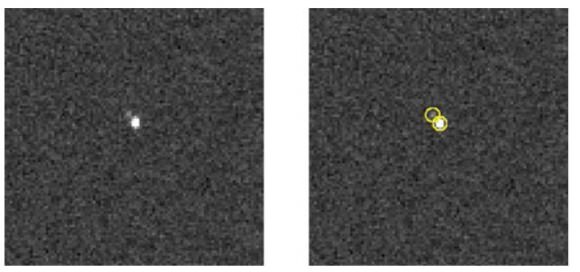
The next major milestone for New Horizons will be its crossing of Neptune’s orbit on August 25. (This just happens to fall on the 25th anniversary of Voyager 2’s closest approach in 1989.) “After that,” Stern says, “we’ll be in ‘Pluto space!'”
Read more: An Ocean on Pluto’s Moon?
Launched on Jan. 19, 2006, New Horizons will make its closest approach to Pluto on July 14, 2015 at 11:49 UTC. Traveling nearly 35,000 mph (55,500 km/h) it’s one of the fastest vehicles ever built, moving almost 20 times faster than a bullet.
Read more from Alan Stern in his latest “PI Perspective” article on the New Horizons web site here, and check out NASA’s mission page here for the latest news as well.
“There is a lot to tell you about over the next 12 weeks, and this is just the warm-up act. Showtime — the start of the encounter — begins in just six months. This is what New Horizons was built for, and what we came to do. In a very real sense, the mission is emerging into its prime.”
– Alan Stern, New Horizons principal investigator
Also, check out a video on Pluto and the New Horizons mission here.
Astronomy Cast Ep. 346: Area 51
Who knows what mysteries lurk at the military’s Area 51 complex in Nevada? Conspiracy theorists and UFO chasers think it’s a big alien coverup. But it’s probably something more boring, like advanced military aircraft. Let’s talk about what we know, and what we think we know about this infamous military base.
Continue reading “Astronomy Cast Ep. 346: Area 51”
Astronomy Cast Ep. 342: Sunsetting Spacecraft
Everything dies, including our technology. But when we’ve hurtled a few thousands pounds of robotic instrumentation to another planet, it gets a little difficult to shut it down and clean up. What do we do when a mission has reached the end of its useful life?
Continue reading “Astronomy Cast Ep. 342: Sunsetting Spacecraft”
Russia’s Second Shot at Phobos May Return Bits of Mars As Well
After the tragic failure of the first Phobos-Grunt mission to even make it out of low-Earth orbit, the Russian space agency (Roscosmos) is hoping to give it another go at Mars’ largest moon with the Phobos-Grunt 2 mission in 2020. This new-and-improved version of the spacecraft will also feature a lander and return stage, and, if successful, may not only end up sending back pieces of Phobos but of Mars as well.
The origins of Phobos have long been a topic of planetary science debate. Did it form with Mars as a planet? Is it a wayward asteroid that ventured too closely to Mars? Or is it a chunk of the Red Planet blasted up into orbit from an ancient impact event? Only in-depth examination of its surface material will allow scientists to determine which scenario is most likely (or if the correct answer is really “none of the above”) and Russia’s ambitious Phobos-Grunt mission attempted to become the first ever to not only land on the 16-mile-wide moon but also send samples back to Earth.
Unfortunately it wasn’t in the cards. After launching on Nov. 9, 2011, Phobos-Grunt’s upper stage failed to ignite, stranding it in low-Earth orbit. After all attempts to re-establish communication and control of the ill-fated spacecraft failed, Phobos-Grunt crashed back to Earth on Jan. 15, impacting in the southern Pacific off the coast of Chile.
But with a decade of development already invested in the mission, Roscosmos is willing to try again. “Ad astra per aspera,” as it’s said, and Phobos-Grunt 2 will attempt to overcome all hardships in 2020 to do what its predecessor couldn’t.
Read more: Russia to Try Again for Phobos-Grunt?
And, according to participating researchers James Head and Kenneth Ramsley from Brown University in Providence, Rhode Island, the sample mission could end up being a “twofer.”
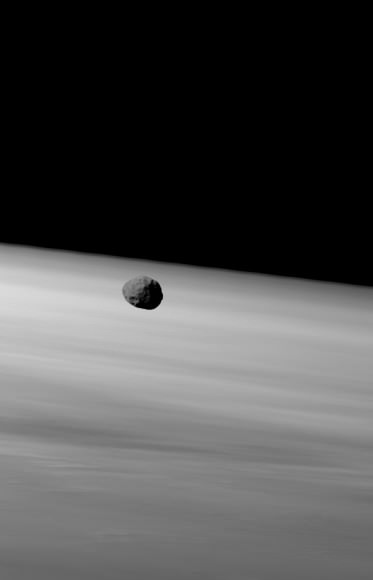
Orbiting at an altitude of only 5,840 miles (9,400 km) Phobos has been passing through plumes material periodically blown off of Mars by impact events. Its surface soil very likely contains a good amount of Mars itself, scooped up over the millennia.
“When an impactor hits Mars, only a certain of proportion of ejecta will have enough velocity to reach the altitude of Phobos, and Phobos’ orbital path intersects only a certain proportion of that,” said Ramsley, a visiting researcher in Brown’s planetary geosciences group. “So we can crunch those numbers and find out what proportion of material on the surface of Phobos comes from Mars.”
Determining that ratio would then help figure out where Phobos was in Mars orbit millions of years ago, which in turn could point at its origins.
“Only recently — in the last several 100 million years or so — has Phobos orbited so close to Mars,” Ramsley said. “In the distant past it orbited much higher up. So that’s why you’re going to see probably 10 to 100 times higher concentration in the upper regolith as opposed to deeper down.”
In addition, having an actual sample of Phobos (along with stowaway bits of Mars) in hand on Earth, as well as all the data acquired during the mission itself, would give scientists invaluable insight to the moon’s as-yet-unknown internal composition.
“Phobos has really low density,” said Head, professor of geological sciences at Brown and an author on the study. “Is that low density due to ice in its interior or is it due to Phobos being completely fragmented, like a loose rubble pile? We don’t know.”
The study was published in Volume 87 of Space and Planetary Science (Mars impact ejecta in the regolith of Phobos: Bulk concentration and distribution.)
Source: Brown University news release and RussianSpaceWeb.com.
See more images of Phobos here.
Sleek GOCE Spacecraft Will Have Uncontrolled Re-entry into Earth’s Atmosphere
The sleek and sexy-looking GOCE spacecraft has been mapping Earth’s gravity for over four years, but soon its xenon fuel will run out and the satellite will end up re-entering our atmosphere. But no one can say for sure when or where the 1-ton satellite will fall.
The Gravity field and steady-state Ocean Circulation Explorer has been orbiting Earth at super-low orbits, mapping out variations in Earth’s gravity with extreme detail. Launched in March 2009, the GOCE spacecraft was designed to fly low and has spent most of its mission roughly 500 km below most other Earth-observing missions, at an altitude of 255 km (158 miles), but has recently been at the lowest altitude of any research satellite at 224 km (139 miles).
With its sleek, aerodynamic design, some have called it the ‘Ferrari of space,’ but we’ve just called it sexy, like a satellite straight out of a James Bond movie.
And the satellite has delivered with unique results of Earth’s ‘geoid’ — precise measurements of ocean circulation, sea-level change and ice dynamics, greatly improving our knowledge and understanding of the Earth’s internal structure. The mission has also been studying air density and wind in space. Its data also produced the first global high-resolution map of the boundary between Earth’s crust and mantle, called the Mohorovicic, or “Moho” discontinuity.
Mission managers predict that in mid-October 2013 the spacecraft will run out of fuel and the satellite will begin its descent towards Earth. There will be no remaining fuel to guide its re-entry, and while most of GOCE is predicted to disintegrate in the atmosphere, several parts might reach Earth’s surface. Experts predict as much as 25% of the spacecraft will survive reentry, as many parts are made of advanced materials, such as carbon-carbon composites.
But when and where these parts might land cannot yet be predicted, ESA says.
As the re-entry time nears, better predictions will be made. Re-entry is expected to happen about three weeks after the fuel is depleted.
ESA says that taking into account that two thirds of Earth are covered by oceans and vast areas are thinly populated, the danger to life or property is very low.
Recently, other larger satellites have made uncontrolled re-entries, such as NASA’s 6-ton UARS spacecraft and Germany’s 2.4-ton ROSAT in 2011 and the 13-ton failed Russian Mars probe, Phobos-Grunt in 2012.
About 40 tons of human-made space debris reach the ground per year, but the spread and size mean the risk of an individual being struck is lower than being hit by a meteorite.
An international campaign will be monitoring the descent, involving the Inter-Agency Space Debris Coordination Committee. The situation is being continuously watched by ESA’s Space Debris Office, which will issue re-entry predictions and risk assessments.
ESA says they will keep the relevant safety authorities permanently updated.
Podcast: The Spacecraft That Wouldn’t Die
In our previous episode, week we explored the various ways spacecraft can die. But this week, we explore the spacecraft (and the scientists) who never give up, snatching victory from the jaws of defeat. We’ll look at clever solutions to potential spacecraft catastrophes.
Click here to download the episode.
Or subscribe to: astronomycast.com/podcast.xml with your podcatching software.
“Death of a Spacecraft” on the Astronomy Cast website, with shownotes and transcript.
And the podcast is also available as a video, as Fraser and Pamela now record Astronomy Cast as part of a Google+ Hangout:
Podcast: Death of a Spacecraft
In the end, everything dies, even plucky space robots. Today we examine the last days of a series of missions. How do spacecraft tend to die, and what did in such heroes as Kepler, Spirit, and Galileo (the missions… not the people).
Click here to download the episode.
Or subscribe to: astronomycast.com/podcast.xml with your podcatching software.
“Death of a Spacecraft” on the Astronomy Cast website, with shownotes and transcript.
And the podcast is also available as a video, as Fraser and Pamela now record Astronomy Cast as part of a Google+ Hangout:
Is It Time to Return to the Moon?
Humans haven’t set foot on the Moon — or any other world outside of our own, for that matter — since Cernan and Schmitt departed the lunar surface on December 14, 1972. That will make 40 years on that date this coming December. And despite dreams of moon bases and lunar colonies, there hasn’t even been a controlled landing there since the Soviet Luna 24 sample return mission in 1976 (not including impacted probes.) So in light of the challenges and costs of such an endeavor, is there any real value in a return to the Moon?
Some scientists are saying yes.
Researchers from the UK, Germany and The Netherlands have submitted a paper to the journal Planetary and Space Science outlining the scientific importance of future lunar surface missions. Led by Ian A. Crawford from London’s Birkbeck College, the paper especially focuses on the value of the Moon in the study of our own planet and its formation, the development of the Earth-Moon system as well as other rocky worlds and even its potential contribution in life science and medicinal research.
Even though some research on the lunar surface may be able to be performed by robotic missions, Crawford et al. ultimately believe that “addressing them satisfactorily will require an end to the 40-year hiatus of lunar surface exploration.”
The team’s paper outlines many different areas of research that would benefit from future exploration, either manned or robotic. Surface composition, lunar volcanism, cratering history — and thus insight into a proposed period of “heavy bombardment” that seems to have affected the inner Solar System over 3.8 billion years ago — as well as the presence of water ice could be better investigated with manned missions, Crawford et al. suggest.
(Read: A New Look At Apollo Samples Supports Ancient Impact Theory)
In addition, the “crashed remains of unsterilized spacecraft” on the Moon warrant study, proposes Crawford’s team. No, we’re not talking about alien spaceships — unless the aliens are us! The suggestion is that the various machinery we’ve sent to the lunar surface since the advent of the Space Age may harbor Earthly microbes that could be returned for study after decades in a lunar environment. Such research could shed new light on how life can — or can’t — survive in a space environment, as well as how long such “contaminants” might linger on another world.
Crawford’s team also argues that only manned missions could offer all-important research on the long-term effects of low-gravity environments on human physiology, as well as how to best sustain exploration crews in space. If we are to ever become a society with the ability to explore and exist beyond our own planet, such knowledge is critical.
And outside of lunar exploration itself, the Moon offers a place from which to perform deeper study of the Universe. The lunar farside, shielded as it is from radio transmissions and other interference from Earth, would be a great place for radio astronomy — especially in the low-frequency range of 10-30 MHz, which is absorbed by Earth’s ionosphere and is thus relatively unavailable to ground-based telescopes. A radio observatory on the lunar farside would have a stable platform from which to observe some of the earliest times of the Universe, between the Big Bang and the formation of the first stars.
Of course, before anything can be built on the Moon or retrieved from its surface, serious plans must be made for such missions. Fortunately, says Crawford’s team, the 2007 Global Exploration Strategy — a framework for exploration created by 13 space agencies from around the world — puts the Moon as the “nearest and first goal” for future missions, as well as Mars and asteroids. Yet with subsequent budget cuts for NASA (a key player for many exploration missions) when and how that goal will be reached still remains to be seen.
See the team’s full paper on arXiv.org here, and check out a critical review on MIT’s Technology Review.
“…this long hiatus in lunar surface exploration has been to the detriment of lunar and planetary science, and indeed of other sciences also, and that the time has come to resume the robotic and human exploration of the surface of the Moon.”
— Ian A. Crawford, Department of Earth and Planetary Sciences, Birkbeck College, UK
Top image from “Le Voyage Dans La Lune” by Georges Méliès, 1902. Second image: First photo of the far side of the Moon, acquired by the Soviet Luna-3 spacecraft on Oct. 7, 1959.
Space Exploration By Robot Swarm
[/caption]
With all there’s yet to learn about our solar system from the many smaller worlds that reside within it — asteroids, protoplanets and small moons — one researcher from Stanford University is suggesting we unleash a swarm of rover/spacecraft hybrids that can explore en masse.
Marco Pavone, an assistant professor of aeronautics and astronautics at Stanford University and research affiliate at JPL, has been developing a concept under NASA’s Innovative Advanced Concepts (NIAC) Program that would see small spherical robots deployed to small worlds, such as Mars’ moons Phobos and Deimos, where they would take advantage of low gravity to explore — literally — in leaps and bounds.
Due to the proposed low costs of such a mission, multiple spacecraft could be scattered across a world, increasing the area that could be covered as well as allowing for varied surfaces to be explored. Also, were one spacecraft to fail the entire mission wouldn’t be compromised.
The concept is similar to what NASA has done in the past with the Mars rovers, except multiplied in the number of spacecraft (and reduced in cost.)
The robots would be deployed from a “mother” spacecraft and spring into action upon landing, tumbling, hopping and vaulting their way across low-mass worlds.
In addition to providing our first views from the surfaces of such worlds, Pavone’s hybrid rovers could also help prepare for future, more in-depth exploration.
“The systematic exploration of small bodies would help unravel the origin of the solar system and its early evolution, as well as assess their astrobiological relevance,” Pavone explains. “In addition, we can evaluate the resource potential of small bodies in view of future human missions beyond Earth.”
Read more from NASA’s Office of the Chief Technologist here.
Photo courtesy of Marco Pavone

